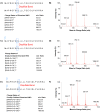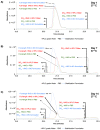Stability Determination of Intact Humanin-G with Characterizations of Oxidation and Dimerization Patterns
- PMID: 36979450
- PMCID: PMC10046509
- DOI: 10.3390/biom13030515
Stability Determination of Intact Humanin-G with Characterizations of Oxidation and Dimerization Patterns
Abstract
Humanin is the first identified mitochondrial-derived peptide. Humanin-G (HNG) is a variant of Humanin that has significantly higher cytoprotective properties. Here, we describe the stability features of HNG in different conditions and characterize HNG degradation, oxidation, and dimerization patterns over short-term and long-term periods. HNG solutions were prepared in high-performance liquid chromatography (HPLC) water or MO formulation and stored at either 4 °C or 37 °C. Stored HNG samples were analyzed using HPLC and high-resolution mass spectrometry (HRMS). Using HPLC, full-length HNG peptides in HPLC water decreased significantly with time and higher temperature, while HNG in MO formulation remained stable up to 95% at 4 °C on day 28. HNG peptides in HPLC water, phosphate-buffered saline (PBS) and MO formulation were incubated at 37 °C and analyzed at day 1, day 7 and day 14 using HRMS. Concentrations of full-length HNG peptide in HPLC water and PBS declined over time with a corresponding appearance of new peaks that increased over time. These new peaks were identified to be singly oxidized HNG, doubly oxidized HNG, homodimerized HNG, singly oxidized homodimerized HNG, and doubly oxidized homodimerized HNG. Our results may help researchers improve the experimental design to further understand the critical role of HNG in human diseases.
Keywords: degradation products; high-performance liquid chromatography (hplc); high-resolution mass spectrometry (hrms); oxidations; peptides; stability.
Conflict of interest statement
M.C.K.: Her research on mitochondria has been supported by Discovery Eye Foundation (DEF). She serves as a member of the Board for DEF. The University of California, Irvine has reviewed and approved the terms of this arrangement in accordance with conflicts-of-interest policies. M.C.K.: Collaborations with Allegro, Ophthalmics, LLC and Almon Therapeutics, Inc. B.D.K: CLINICAL RESEARCH: Alcon, Alimera, Allegro, Allergan, Apellis, Clearside, Genentech, GSK, Ionis, jCyte, Novartis, Regeneron, ThromboGenics; CONSULTANT: Alimera, Allegro, Allergan, Cell Care, Dose, Eyedaptic, Galimedix, Genentech, Glaukos, Interface Biologics, jCyte, Novartis, Ophthotech, Regeneron, Revana, Theravance Biopharma.
Figures













References
-
- Hashimoto Y., Niikura T., Tajima H., Yasukawa T., Sudo H., Ito Y., Kita Y., Kawasumi M., Kouyama K., Doyu M., et al. A Rescue Factor Abolishing Neuronal Cell Death by a Wide Spectrum of Familial Alzheimer’s Disease Genes and Aβ. Proc. Natl. Acad. Sci. USA. 2001;98:6336–6341. doi: 10.1073/pnas.101133498. - DOI - PMC - PubMed

